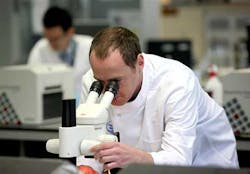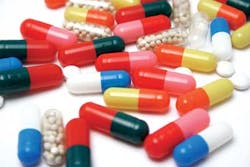Priority Substances: Impact on Water Utilities
With the European Commission proposing to add 15 additional chemicals to the list of pollutants that are monitored and controlled in EU surface waters, utilities should take note. Estimates suggest improvements needed to measure these substances in the UK alone would amount to 27 billion Euros. Jeremy Josephs investigates.
The name Albert Szent-Györgyi might not flow so easily from one's lips but it was the late, great Hungarian physiologist, and Nobel Prize winner, who told us that water is life's mater and matrix, mother and medium. Hardly surprising, then, that in virtually every culture and civilisation, from the ancient Greeks to those who follow the Taoist tradition of today, that water has come to be closely associated with notions of purity and fertility.
But what if our water is not quite what it's cracked up to be? Could it be the case that our drinking water contains traces of ethinyloestradiol - that is to say orally bio-active estrogen used in almost all modern formulations of combined oral contraceptive pills? Throw in a touch of diclolfenac (an anti-inflammatory drug) add a little cypermethrin (a synthetic pyrethroid used as an insecticide) and we have surely got ourselves an interesting mix.
Playing regulatory catch up
Traces of all of these substances – to name but a few - can and do appear as micro pollutants in our drinking water. Which immediately throws up the question of how water companies can monitor, measure and, hopefully, reduce the impact of these so-called 'priority substances'. Of course a legislative framework exists – both at national and European level – but the situation can at times come across as fast-moving and free-flowing as water itself. And with potentially massive financial implications for those charged with the responsibility of delivering fresh and clean - one hesitates to use the word pure - drinking water to their customers.
The question is whether or not water providers will be able to keep up not just with new forms of chemical pollution but with the volume of legislative requirements emanating from Brussels designed to reduce water pollution risks. For in January of this year the Commission proposed adding 15 chemicals to the existing list of 33 pollutants that are monitored and controlled in EU surface waters. They were selected, understandably enough, via scientific evidence that they might pose a significant risk to the environment or human health.
This update is coming via a revision of the directive on priority substances in the field of water quality, after an exhaustive three-year review, which considered the risks posed by no less than 2000 substances. The proposed 15 additional priority substances can be divided into the following categories: plant protection product substances: Aclonifen, Bifenox, Cypermethrin, Dicofol, Heptachlor, Quinoxyfen; substances used in biocidal products: Cybutryne, Dichlorvos, Terbutryn; industrial chemicals: Perfluorooctane sulfonic acid (PFOS), Hexabromocyclododecane (HBCDD); combustion by-products: Dioxin and Dioxin-Like PCBs.
The key and innovative development here is that for the first time in the history of the management of dangerous and priority substances certain pharmaceuticals have been added including - 17 alpha-ethinylestradiol (EE2), 17 beta-estradiol (E2) and diclofenac.
View from Brussels
Europe's Environment Commissioner, Janez Potocnik, has been entirely unapologetic about these new proposals, claiming that water pollution is one of the environmental worries most frequently cited by EU citizens.
"I therefore welcome these advances", he said, "as it is clearly answering people's expectations. These 15 additional chemicals need to be monitored and controlled to ensure that they don't pose a threat."
His Brussels office made it clear that the inclusion of these pharmaceutical products does not for one moment throw into question the medicinal value of these substances – merely addresses the potential harmful effects of their presence in the aquatic environment. Concentrations above the proposed standards can also affect fish health, possibly impacting upon successful reproduction, in addition to harming other living organisms.
It is not clear if the Commission was influenced in any way by alarmist reports in the popular press claiming that up to half the male fish in Britian's lowland rivers were changing sex – not to mention negatively impacting on human sperm counts up and down the land. Whatever the case, the next steps are that the Commission is proposing the revised list as part of a Directive amending the Water Framework Directive and the Environment Quality Standard Directive. These proposals are now slowly but surely making their way through the Council and Parliament with a view to discussion and adoption. All of which could well mean that member states will be obliged to meet these new and more exacting environmental standards by 2021.
Key industry players, such as Suez Environnement, are embracing the fight against micropollutants in water, using innovative prevention tools such as Nitrascope, carrying out research via its International Centre for Water and Environmental Research. It says it is engaging in the fight to reduce liquid waste in the environment under the auspices of its Rhodanos programme.
Suez Environnement's approach is that the most effective way of addressing this issue is by reducing waste at source. "This is the least costly solution", the company affirms, "and the simplest to implement. It is also possible to create special collectors, or local water treatment plants. This will make it easier to treat, on site, waste from a food processing plant, for example, rather than mix it with community waste."
Suez might well be saying all of the right things in terms of both image and compliance but it remains to be seen how they will adapt to these new and more stringent requirements emanating from Brussels.
Utility alarm bells
The truth is that for water companies up and down the UK alarm bells have been ringing. And it would appear not without some justification. For unlike pesticides and industrial chemicals that could conceivably have their uses restricted – the only option for water companies will be end-of-pipe treatment at the sewage treatment works. This is because the steroid oestrogens proposed, for example, are a product of human metabolism.
Thames Water's CEO, Martin Baggs, highlighted his concerns relating to the Brussels proposals in his address at the Institute of Water conference which took place in London this Spring – and claimed that when it came to traces of oral contraception in water – no less than 99% of sites would be likely to fail the new standards. Furthermore, 65% of sites would be unable to comply with limits relating to anti-inflammatories and over three quarters of sites would fare similarly in respect of insecticides. He also claimed that the Commission's Impact Assessment which required both ethinyloestradiol to fall to a level of 0.0004 ug/l could mean significantly higher costs for consumers. And he wasn't talking about a few additional pennies onto the monthly standing order. His assessment was that the cost of improvements required would amount to 27 billion Euros in the UK alone – the equivalent to around a quarter of the total investment in the UK water industry since 1989.
In financial terms this would mean a massive additional eighteen Euros per inhabitant per year. He also had a more practical complaint – that some of the levels set out in the proposals are so low that there are at present no means of measuring compliance. The balance between the introduction of these new standards and the potential compliance costs was, he argued, all out of sync.
Reports and views
A recent report by the World Health Organisation would also appear to contradict the proposed Brussels regulations.
"Currently, analysis of the available data indicates that there is a substantial margin of safety between the very low concentrations of pharmaceuticals that would be consumed in drinking-water and the minimum therapeutic doses, which suggests a very low risk to human health. Based on this finding, the development of formal health-based guideline values for pharmaceuticals in the WHO's Guidelines for drinking-water quality is not considered to be necessary."
Nor does the UK Parliament seem to be overly impressed with the proposed revisions to the Priority Substance Directive. EU Sub-Committee D of the House of Lords has been examining this question and their conclusions broadly support the concerns being voiced by Thames Water.
"We see a need for the Government, and the Commission, potentially through its European Innovation Partnership on Water, to acquire more knowledge of the risk posed, principally by the pharmaceutical substances being added to the list, and of cost-effective methods of reducing this risk before effluent containing the substances requires wastewater treatment."
The Institute of Environment and Health, based at Cranfield University, recently reviewed the latest endocrine disrupting chemical research implications for drinking water and concluded that "in the light of current scientific understanding of the way mixtures of chemicals interact, it was found that even drinking waters containing the predicted worse-case level of each of the oestrogenically-active chemically identified would not constitute a significant risk to human health when considered in terms of the equivalence to consumption of the natural hormone oestradiol".
These findings happen to complement a previous report issued by the Drinking Water Inspectorate: "Concentrations of pharmaceuticals and drugs in drinking waters are generally significantly lower than seen in surface waters indicating that the treatment systems in use in England and Wales are effective in removing these contaminants. It would therefore appear that low levels of pharmaceuticals and illicit drugs in drinking waters do not pose an appreciable risk to human health."
Given the numerous reports and views, there appears to be a constant tug-of-war between environmental interests on the one hand and commercial concerns on the other. Who will eventually emerge victorious of course remains to be seen, although the likelihood is that a compromise will be reached on the not unreasonable grounds that both 'sides' ultimately share the same concerns – a commitment to ensuring the long-term health of EU member states' watercourses.
Technology requirements
While the debate goes on, a more practical challenge awaits: the issue of monitoring and measurement. One thing is clear – this is not a simple task. There is no one 'piece of kit' that could possibly be used for all types of micropollutants, let alone the new additions on the Brussels list.
Of course different types of substances will require different approaches for analysis. A gas chromatography and mass spectrometry approach used in combination can indeed detect a range of substances but certainly not always reliably so and in any event will require additional stages and techniques to measure concentrations rather than mere presence.
The key step is clearly extraction but the problem is that the substances are at such tiny concentrations that a large volume of sample is required to begin with, from which one then has to effectively concentrate the pollutant in order to be able to measure it. Another key issue is the consistency and reproducibility of the results so that findings from one laboratory can be safely and reliably compared withthose from another. This would in turn mean that detailed protocols will be required.
"Are we at Thames Water, for example", Howard Brett, the company's expert on the subject asks rhetorically, "to be obliged to measure every trace of everything right down to the last molecule? Because if we are, such compliance is going to come with a massive cost and it's only right that consumers should know about that."
The Oxford English Dictionary provides us with the definition of pure - not mixed or adulterated with any other substance or material – which certainly means that there is no such thing as pure water. Never has been. Never will be either. But how to ensure that it remains as pure as possible? And in any event what do we mean by such a question? As pure as reasonably possible? If so, what is reasonable? As pure as commercially possible? As pure as environmentally possible? The debate between these competing objectives continues. Not least in the corridors of powers – both in Brussels and elsewhere.



